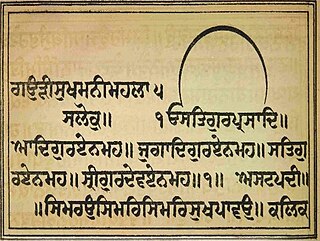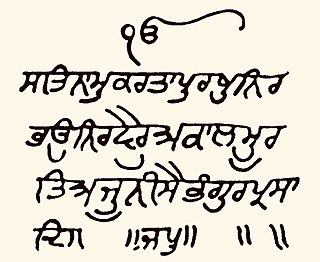| Part of a series on |
| Sikhism |
|---|
 |
Irrespective of the native-language meaning of the Mantra, the standard English translation neutralises the implied Gender of God in Sikhism.
| Part of a series on |
| Sikhism |
|---|
 |
Irrespective of the native-language meaning of the Mantra, the standard English translation neutralises the implied Gender of God in Sikhism.
The scripture of Sikhism is the Gurū Granth (GG). Printed as a heading for the Guru Granth, and for each of its major divisions, is the Mul Mantra, a short summary description of God, in Punjabi. Sikh tradition has it that this was originally composed by Nanak Dev (1469–1539), the founder of Sikhism.
ਸੁੰਨ ਮੰਡਲ ਇਕੁ ਜੋਗੀ ਬੈਸੇ ॥ ਨਾਰਿ ਨ ਪੁਰਖੁ ਕਹਹੁ ਕੋਊ ਕੈਸੇ ॥ ਤ੍ਰਿਭਵਣ ਜੋਤਿ ਰਹੇ ਲਿਵ ਲਾਈ ॥ ਸੁਰਿ ਨਰ ਨਾਥ ਸਚੇ ਸਰਣਾਈ ॥
Sunn mandal ik Yogi baiseh. Naar nuh purakhu kahahu kou kaiseh. Tribhavan joth raheh liv laaee. Suri nar naath sacheh saranaaee
The Yogi, the Primal Lord, sits in the Realm of Absolute Stillness (state free of mind's wanderings or Phurne). (Since God) is neither male nor female; how can anyone describe Him? The three worlds center their attention on His Light. The godly beings and the Yogic masters seek the Sanctuary of this True Lord.
— SGGS. Ang 685
However, the Guru Granth Sahib consistently refers to God as "He" and "Father" (with some exceptions), typically because the Guru Granth Sahib was written in north Indian Indo-Aryan languages (mixture of Punjabi and Sant Bhasha, Sanskrit with influences of Persian) which have no neutral gender. English translations of the teachings may eliminate any gender specifications. From further insights into the Sikh philosophy, it can be deduced that God is, sometimes, referred to as the Husband to the Soul-brides, in order to make a patriarchal society understand what the relationship with God is like. Also, God is considered to be our Father, Mother, and Companion. [2]
The sixth word of the mantra, purakhu, is the Punjabi form of Sanskrit puruṣa (पुरुष), meaning man (personal and male). Verse 5 of a 16-verse hymn in the 10th mandala (or cycle) of the Sanskrit Rigveda (RV) called puruṣa sūkta , speaks of a primal man, Puruṣa, from whom Viraj (woman) was born, being himself then reborn of her.
The masculine gender sense of purakhu in the Mantra is found in a verse like the following.
In Sikhism, a person has two genders – one the physical gender i.e. sex (male or female), and the other the spiritual gender (which is always female – regardless of a person's physical sex). Waheguru is alluded culturally as the spiritual husband, reunion with Which is the desire of every spiritual bride – all of us.
Some references are inclusive, where God is both Mother and Father.
There is at least one reference to God as Mother, without reference to a Father.
This overly literal interpretation of the cultural references in the Guru Granth Sahib run counter to the basic premise of the Mul Mantar – that God has no form. Hence, an anthropomorphic religious (as opposed to cultural) interpretation is a contradiction in terms. The inherent anti-anthropomorphism of Sikhism scuttles oany idea of religious gender of Waheguru. The God in Sikhism is considered as Jot Saroop (Luminescence Light) so no question of gender but depending upon the feeling of the devotee God can turn Itself to any shape a child (girl or boy), a young man or woman, old man or woman or whatever It desire to be i.e. It is not governed by any law or rule and It is free to do anything. So in Sikhism, God is considered to be without form or gender and can't be described. [12]
Waheguru is a term used in Sikhism to refer to God as described in Guru Granth Sahib. It is the most common term to refer to God in modern Sikhism.
The following outline is provides an overview of Sikhism, or Sikhi.

Japji Sahib (Punjabi: ਜਪੁਜੀ ਸਾਹਿਬ, pronunciation: ) is the Sikh thesis, that appears at the beginning of the Guru Granth Sahib – the scripture of the Sikhs. It was composed by Guru Angad, and is mostly the writings of Guru Nanak. It begins with Mool Mantra and then follow 38 paudis (stanzas) and completed with a final Salok by Guru Angad at the end of this composition. The 38 stanzas are in different poetic meters.

Jaap Sahib is the morning prayer of the Sikhs. The beaded prayers were composed by the Tenth Sikh Guru, Guru Gobind Singh and is found at the start of the Sikh scripture Dasam Granth. This Bani is an important Sikh prayer, and is recited by the Panj Pyare while preparing Amrit on the occasion of Amrit Sanchar (initiation), a ceremony held to Amrit initiates into the Khalsa and it is a part of a Sikh's Nitnem. The Jaap Sahib is reminiscent of Japji Sahib composed by Guru Nanak, and both praise God.

Sukhmani Sahib, known under the title of Gauri Sukhmani in the scripture, is usually translated to mean Prayer of Peace is a set of 192 padas present in the holy Guru Granth Sahib, the main scripture and living Guru of Sikhism from Ang 262 to Ang 296. This Gurbani text was written by the 5th Guru, Guru Arjan (1563–1606) at Amritsar in around 1602. Guru Arjan first recited the bani at Gurdwara Barth Sahib in the Gurdaspur district of Punjab, India.

The laava phere, also known as Lavan, are the four hymns of the Anand Karaj which form the main part of this ceremony. The four hymns are from the Guru Granth Sahib, the Sikh holy scriptures and appear on Ang 773 to 774 of the total of 1430. The Laavaan Shabad was written by the Fourth Guru, Guru Ram Daas Ji.

Ik Onkar, also spelled Ek Onkar or Ik Oankaar ; literally, "one Om", hence interpreted as "There is only one God or one Creator") is a phrase in Sikhism that denotes the one supreme reality. It is a central tenet of Sikh religious philosophy.
In Sikhism, Nām Japō (Punjabi: ਨਾਮ ਜਪੋ, pronunciation: ), also known as Naam Japna or Naam Simran, refers to the meditation or contemplation of the various Names of God, especially the chanting of the word "Waheguru" representing the formless being, the creator of all the forms, and the being omnipresent in all forms.

The Mūl Mantar is the opening verse of the Sikh scripture, the Guru Granth Sahib. It consists of twelve words in the Punjabi language, written in Gurmukhi script, and are the most widely known among the Sikhs. They summarize the essential teaching of Guru Nanak, thus constituting a succinct doctrinal statement of Sikhism.
The gender of God can be viewed as a literal or as an allegorical aspect of a deity.

The Sarbloh Granth or Sarabloh Granth, also called Manglacharan Puran or Sri Manglacharan Ji, is a voluminous scripture, composed of more than 6,500 poetic stanzas. It is traditionally attributed as being the work of Guru Gobind Singh, the tenth Sikh guru. Scholars, on the other hand, attribute the work to after the Guru's death, being authored by an unknown poet. The work is mostly revered by the Nihang sect.
Ahankar, commonly rendered as Hankaar or Hankār based upon its pronunciation in Punjabi, is a Gurmukhi word originating from the Sanskrit word Ahankāra which translates to mean "ego" or "excessive pride" due to one's possessions, material wealth, spirituality, beauty, talents, physical strength, intelligence, authoritative powers, charity work, amid others. It is one of the five thieves of Sikhism which hinder one's spiritual's progression.

The principal Sikh scripture is the Adi Granth, more commonly called the Guru Granth Sahib. The second most important scripture of the Sikhs is the Dasam Granth. Both of these consist of text which was written or authorised by the Sikh Gurus.

In Sikhism, God is conceived as the Oneness that permeates the entirety of creation and beyond. It abides within all of creation as symbolized by the symbol Ik Onkar. The One is indescribable yet knowable and perceivable to anyone who surrenders their egoism and meditates upon that Oneness. The Sikh gurus have described God in numerous ways in their hymns included in the Guru Granth Sahib, the holy scripture of Sikhism, but the oneness of formless God is consistently emphasized throughout.

In Sikh discipline, a Sikh is required by the Sikh Gurus to live a disciplined life by doing pure and righteous deeds and actions. The following are the list of activities that a Sikh should engages in:
The following list consists of concepts that are derived from both Sikh and Indian tradition. The main purpose of this list is to disambiguate multiple spellings, to make note of spellings no longer in use for these concepts, to define the concept in one or two lines, to make it easy for one to find and pin down specific concepts, and to provide a guide to unique concepts of Sikhism all in one place.
Antam Sanskar refers to the funeral rites in Sikhism. Antam means "final", while sanskar means "rite".

Guru Maneyo Granth refers to the historic statement of the 10th Sikh Guru, Guru Gobind Singh (1666–1708) shortly before his demise on affirming the sacred scripture Adi Granth as his successor, thereby terminating the line of human Gurus. Installed as the Guru Granth Sahib, it is now the central holy scripture of Sikhism, and the eternal living Guru of all Sikhs. It is central to Sikh worship as it is said to imbibe the one light of the creator manifested in the Ten Sikh Gurus‐one spirit in ten forms.

The Guru Granth Sahib, is the central religious text of Sikhism, considered by Sikhs to be the final sovereign Guru of the religion. It contains 1430 Angs, containing 5,894 hymns of 36 saint mystics which includes Sikh gurus, Bhagats, Bhatts and Gursikhs. It is notable among foundational religious scriptures for including hymns from writers of other religions, namely Hindus and Muslims. It also contains teachings of the Sikh gurus themselves.

Gatha is a bani by the fifth Sikh Guru, Guru Arjan Dev. It appears on ang 1360-1361 of Guru Granth Sahib - the holy scripture and living Guru of Sikhs. Gatha is made of 24 saloks. The main theme of Gatha is the praise of Waheguru and the importance of devotion to Waheguru. Gatha is a Sanskrit word translating to song or verse and refers to any composition out of the Veda. It also means katha (commentary). It is also the name of the language the composition is written in.